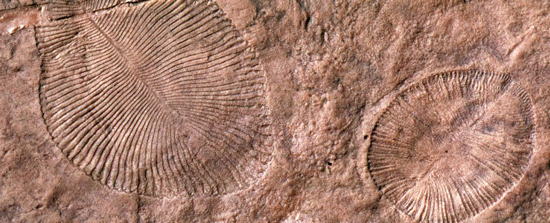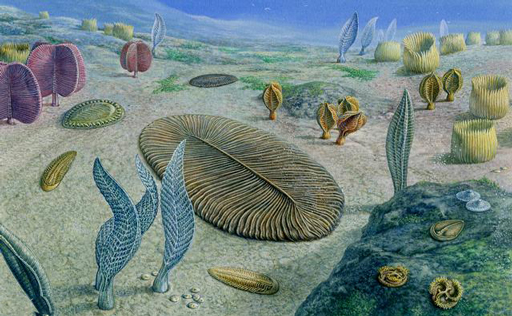Mysterious Dickinsonia Definitely an Animal
Soft-bodied Dickinsonia – An Animal
The Late Proterozoic saw the evolution of a variety of bizarre, multi-cellular organisms, fossils of which, are extremely rare and what evidence we have, does little to shed light on where on the tree of life these organisms would sit.
Food chains existed but the organisms that made up the biota are so strange and so unlike anything alive today, it’s almost as if palaeontologists looking at Ediacaran fauna are studying life on another planet. True, Earth back in the Ediacaran geological period (635 to 542 million years ago), was a very different place than it is now. However, one group of scientists studying one type of Ediacaran organism – Dickinsonia, have confirmed previous studies that place this peculiar disc-shaped organism as definitely belonging to the Kingdom Animalia.
Dickinsonia, looks like nothing alive today, but it has been classified as metazoan, or possibly a placozoan – that puts it in the same Kingdom as you and me.
Dickinsonia – Classified as an Animal
Picture credit: University of Oregon
What on Earth was Dickinsonia?
Living more than 550 million years ago, Dickinsonia fossils do not resemble any living organism. It is round or oval in shape, segmented with a distinct “head” and “tail” end, but which was the front and which was the back is debated and whether the terms “head” and “tail” are applicable at all is disputed. As far as we at Everything Dinosaur are aware, no evidence of a gut or other internal structures have been found. These fossils, some of which are up to a metre in diameter have been described as early jellyfish, segmented worms, fungi and even an early form of lichen.
Hundreds of examples showing all stages of growth (ontogeny) and in various states of preservation have been found, most famously from the Ediacara Hills in South Australia, from which this geological period is named.
In 1946, geologist Reginald Spriggs discovered fossilised imprints in rocks in this area that represent a marine biota, an ancient sea floor. This was the first known fossil record of multi-cellular life on Earth that predates the Cambrian. This diverse and exquisitely preserved community of ancient organisms represents a significant snapshot of our planet’s geological heritage, but working out what these fossils represent and where they fit in with the evolution of Cambrian organisms (if they do fit in), is very much open to debate.
A New Scientific Study
In a new study, carried out by scientists at Bristol, Cambridge and Oxford universities in conjunction with the British Geological Survey, strong support is provided for the theory that Dickinsonia was an animal, that it has affinities with the Metazoa, specifically the Eumetazoa plus the Placozoa. The research is published in the “Proceedings of the Royal Society B”.
Finding a Place in Biology for Dickinsonia

The Ediacaran fossil Dickinsonia costata, specimen P40135 from the collections of the South Australia Museum.
Picture credit: Dr Alex Liu (Cambridge University)
The Metazoa
The Metazoa are a very basal clade of the Kingdom Animalia. They are animals that have three types of tissue layer in the embryo and are multi-cellular). Metazoans are regarded as a sister group to the Porifora (Sponges). The Placozoa are associated with the metazoans, they are represented by one living genus – Trichoplax and they are flattened, multi-cellular organisms that absorb nutrients through their surface area.
Dr Renee Hoekzema (Oxford University) and one of the authors of the research paper explained:
“Dickinsonia belongs to the Ediacaran biota, a collection of mostly soft-bodied organisms that lived in the global oceans between roughly 580 and 540 million years ago. They are mysterious because despite there being around two hundred different species, very few of them resemble any living or extinct organism and therefore what they were, and how they relate to modern organisms, has been a long-standing palaeontological mystery.”
The team examined a large number of Dickinsonia fossils, of varying growth stages and applied a quantitative method for plotting the development of the organism, essentially how the animal grew and changed as it got bigger. An assumption was made as to which fossils represented juveniles and which ones were adults and based on this, the researchers concluded that the growth body plan for Dickinsonia placed it within the Animalia.
This study was undertaken using the principle that growth and development are “conserved” within lineages. To put it another way, the way a group of organisms grows today would not have changed significantly from the way its ancestors grew hundreds of millions of years ago.
Dickinsonia Composed of Multiple “Units”
Dickinsonia is composed of multiple “units” that run down the length of its body. The researchers counted the number of these units in numerous specimens, measured their lengths and plotted these against the relative “age” of the unit, assuming growth from a particular end of the organism.
This data produced a plot with a series of curves, each of which tracked how the organism changed in the size and number of units with age, enabling the researchers to produce a computer model to replicate growth in the organism and test previous hypotheses about where and how growth occurred.
Dr Hoekzema added:
“We were able to confirm that Dickinsonia grows by both adding and inflating discrete units to its body along its central axis. But we also recognised that there is a switch in the rate of unit addition versus inflation at a certain point in its life cycle. All previous studies have assumed that it grew from the end where each “unit” is smallest, and was therefore considered to be youngest. We tested this assumption and interpreted our data with growth assumed from both ends, eventually coming to the conclusion that people have been interpreting Dickinsonia as having grown at the wrong end for the past seventy years.”
The First of the Ediacaran Biota to be Described
Dickinsonia was the first organism from the Ediacaran fossil material (Flinders Range), to be described (1947). Using this computer model, the researchers were able to cross-reference data with studies into how this organism may have moved across the seabed and concluded that it was an early animal, belonging to either the Placozoa or the Eumetazoa.
An Illustration of Life in the Ediacaran Period
Picture credit: John Sibbick
Dr Hoekzema went onto state:
“This is one of the first times that a member of the Ediacaran biota has been identified as an animal on the basis of positive evidence.”
The methodology used in this study could be applied to other Ediacaran organisms, so long as there are sufficient fossils to comprise a significant data set.
Co-author Dr Liu stated:
“This finding demonstrates that animals were present among the Ediacaran biota and importantly confirms a number of recent findings that suggest animals had evolved several million years before the “Cambrian Explosion” that has been the focus of attention for studies into animal evolution for so long. It also allows Dickinsonia to be considered in debates surrounding the evolution and development of key animal traits such as bilateral symmetry, segmentation and the development of body axes, which will ultimately improve our knowledge of how the earliest animals made the transition from simple forms to the diverse range of body plans we see today.”
Visit the Everything Dinosaur website: Everything Dinosaur.



